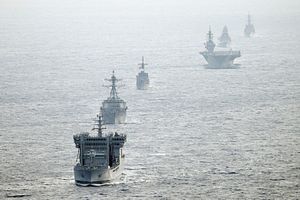For J.R.R Tolkien fans familiar with the “Lord of the Rings” trilogy, Middle Earth is a fascinating political landscape where elves and men — along with a few dwarves and hobbits — have rallied together to ward off evil. Today, the “hobbits” of the world could use some guidance on how to find their own place in a titanic power struggle.
The modern day Indo-Pacific is a geopolitical construct spanning a vast maritime space joining the Indian and Pacific Oceans, but placing more emphasis on Asia. It is clear now after the launch of the U.S. Department of Defense’s Indo Pacific Report in 2019 that the United States perceives China as dangerous to its position and influence. Therefore, amplifying its capabilities, the U.S. works closely with allies in the maritime domain to counter Chinese naval ambitions. This situation places small states in the region in the precarious position of pursuing an equidistant foreign policy to ward off threats to their sovereignty and territorial integrity, all the while improving both security and economic relations. Therefore, small states, like the hobbits of Tolkien’s Shire, must carefully negotiate with powerful giants, being fully aware of their agenda.
The so-called “Quad” countries (the United States, Australia, Japan, and India) initially banded together as an informal alliance to provide humanitarian assistance to countries affected by the Indian ocean tsunami in 2004. Until the launch of the U.S. Indo-Pacific Report and the Free and Open Indo Pacific in official defense and foreign policy white papers, the Quad’s “mission” remained amorphous. The Free and Open Indo Pacific concept as outlined rests on three main pillars: Preparedness, partnerships, and the promotion of a networked region. The Indo-Pacific Report was very security focused on matters such as force-multiplying, intra-Asian security partnerships, and military cooperation vis-à-vis promoting democratic peace and an international rules-based order. The Quad has up to date conducted joint military exercises including RIMPAC, Malabar, AUSINDEX with a focus on navy-navy cooperation and engaging with coast guard agencies on improving their constabulary roles to promote freedom of navigation.
The U.S. Indo-Pacific Report 2019 boldly denigrates China as a “revisionist power,” Russia as a “revitalized malign actor,” and North Korea as a “rogue state” in a fit of dramatic irony. China remains within the top three trade partners of the United States after Mexico and Canada according to the most recent statistics and continues to be omnipresent as a regional power as it embarks on mutually beneficial regional trading agreements such as the Regional Comprehensive Economic Partnership (RCEP).
The U.S.-China trade wars have had severe implications on the global economy. U.S. think tanks such as the Brookings Institute and Council for Foreign Relations opine that China’s state controlled economic model and industrial policy are incongruent to the rules of the World Trade Organization where members have market-based systems.
Until Secretary of State Mike Pompeo’s speech at the Indo-Pacific Business Forum in 2018, how “free” and “open” applied to economics and trade weren’t as clear. The United States now has a more elaborate Indo-Pacific economic strategy with three main initiatives including: The Digital Connectivity and Cybersecurity Partnership (DCCP), Infrastructure Transaction and Assistance Network (ITAN), and Asia Enhancing Development and Growth through Energy (AsiaEDGE). Washington is thus leveraging smart power; on the one hand it amplifies military capabilities through the Quad while also engaging with Indo-Pacific countries through the initiatives mentioned above. This presents both opportunities and challenges to small states.
A particular example could be sought from Sri Lanka. The small island nation is currently debating on signing the Millennium Cooperation Compact, a five-year, $480 million grant, as well as two highly contentious U.S. defense proposals: The Acquisition and Cross-Services Agreement and the Status of Forces Agreement. U.S. pressure to engage with Sri Lanka in deeper cooperation on both the economic and security fronts is unsurprising as Sri Lanka is a major partner of China’s BRI.
Against the backdrop of a rising Asia, and a multipolar world that struggles at keeping China at bay, smaller states play a quintessential role in their delicate balancing when more powerful countries are engaged in hedging. Countries such as Sri Lanka, Bangladesh, and Nepal have adopted equidistant foreign policies, engaging with all countries and attempting to gain the most from them. Anushka Wijethilake, a Sri Lankan economist, opines that the U.S.-China trade wars may present opportunities for smaller states too. Since non-Chinese companies owning business in China are also affected by the trade wars, there will be a redrawing of supply chains to Asian countries. Sri Lanka could therefore reform itself and liberalize the economy to improve its own investor space to develop apparel, rubber, and technological industries.
Natasha Fernando is a Program Officer at the Regional Center for Strategic Studies in Colombo, Sri Lanka. She is also the South Asian Regional Liaison Officer at Global Partnership for the Prevention of Armed Conflict (GPPAC).

































